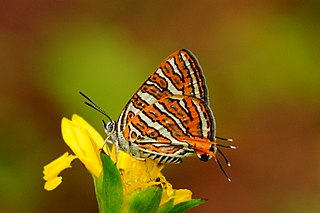
Cigaritis vulcanus, the common silverline, is a species of lycaenid or blue butterfly found in Asia. It was first described by Johan Christian Fabricius in 1775.
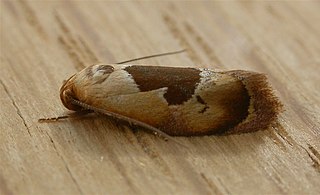
Hoplomorpha camelaea is a moth in the family Oecophoridae first described by Edward Meyrick in 1888. It is found in Australia, where it has been recorded from Victoria, Queensland, New South Wales and the Australian Capital Territory.
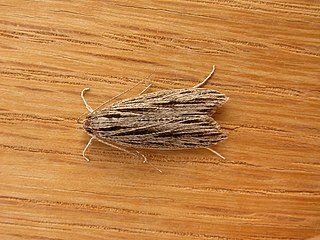
Leistarcha scitissimella is a moth of the family Xyloryctidae. It is found in Australia, where it has been recorded from the Australian Capital Territory, New South Wales and Queensland.

Plectophila discalis is a moth of the family Xyloryctidae first described by Francis Walker in 1865. It is found in Australia, where it has been recorded from New South Wales, Queensland and Victoria.
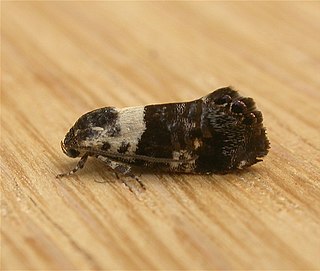
Eupselia aristonica is a species of moth of the family Depressariidae. It is found in Australia, where it has been recorded from New South Wales, the Australian Capital Territory, Victoria and Tasmania.

Trichoptilus ceramodes is a moth of the family Pterophoridae that is found in Australia, including New South Wales and South Australia.

Nycteola revayana, the oak nycteoline, is a moth of the family Nolidae. The species was first described by Giovanni Antonio Scopoli in 1772. It is found from Europe and east across the Palearctic to Japan and India.
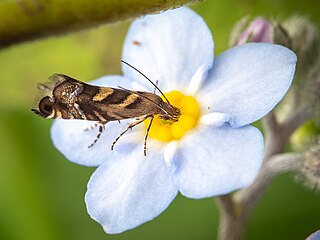
Glyphipterix tungella is a species of sedge moth in the genus Glyphipterix. It is endemic to New Zealand and is found throughout the country. Larvae mine the leaves of small sedges. Adults of this species are day flying and inhabit sheltered scrub or grassy areas and forest clearings.

Glaucocharis pyrsophanes is a moth in the family Crambidae. It was described by Edward Meyrick in 1882. It is endemic to New Zealand.
Catacometes hemiscia is a moth in the family Oecophoridae. It was described by Edward Meyrick in 1883. It is found in Australia, where it has been recorded from New South Wales.
Antaeotricha balanocentra is a species of moth of the family Depressariidae. It is found in Guyana.
Catoryctis subnexella is a moth in the family Xyloryctidae. It was described by Francis Walker in 1864. It is found in Australia, where it has been recorded from the Australian Capital Territory, New South Wales, South Australia and Tasmania.
Clerarcha dryinopa is a moth in the family Xyloryctidae. It was described by Edward Meyrick in 1890. It is found in Australia, where it has been recorded from the Australian Capital Territory, New South Wales and Victoria.
Lichenaula undulatella is a moth in the family Xyloryctidae. It was described by Francis Walker in 1864. It is found in Australia, where it has been recorded from New South Wales, Queensland and Western Australia.
Xylorycta chrysomela is a species of moth in the family Xyloryctidae. It was described by Oswald Bertram Lower in 1897. It is found in Australia, where it has been recorded from the Northern Territory and Queensland.
Eclecta is a monotypic moth genus in the family Depressariidae. Its only species, Eclecta aurorella, has been found in the Australian state of New South Wales. Both the genus and species were first described by Edward Meyrick in 1883.
Gonionota comastis is a moth in the family Depressariidae. It was described by Edward Meyrick in 1909. It is found in Peru and Colombia.
Thudaca calliphrontis is a moth in the family Depressariidae. It was described by Edward Meyrick in 1893. It is found in Australia, where it has been recorded from South Australia.

Thudaca heterastis is a moth in the family Depressariidae. It was described by Edward Meyrick in 1893. It is found in Australia, where it has been recorded from Western Australia.
Thudaca ophiosema is a moth in the family Depressariidae. It was described by Edward Meyrick in 1893. It is found in Australia, where it has been recorded from Western Australia.









